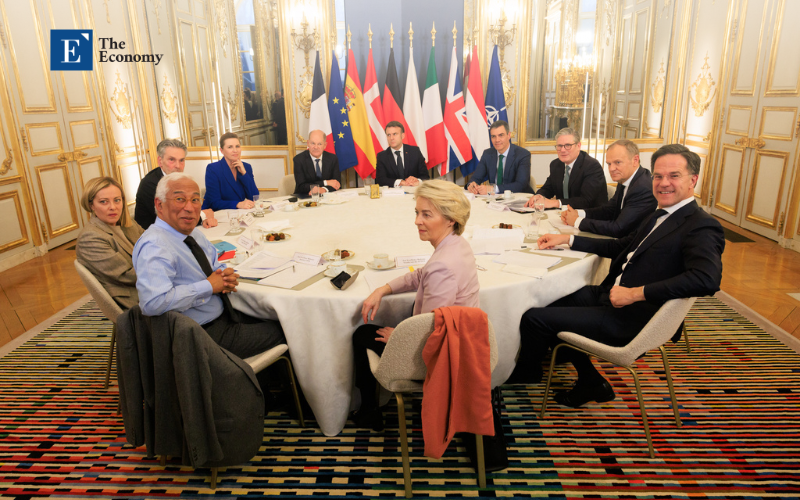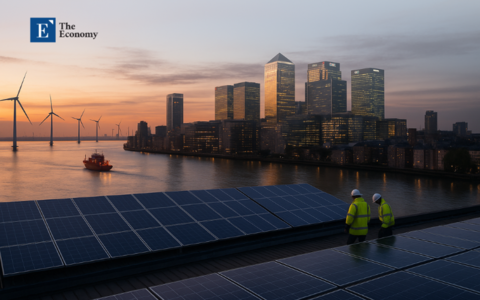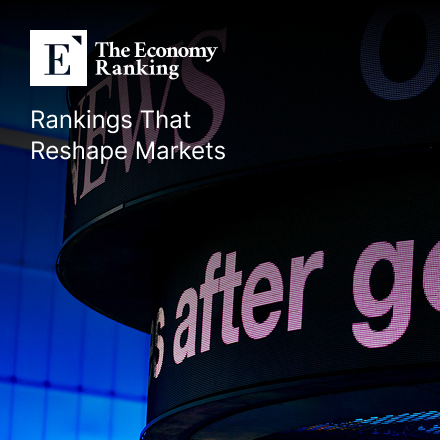Input
Changed
This article is based on ideas originally published by VoxEU – Centre for Economic Policy Research (CEPR) and has been independently rewritten and extended by The Economy editorial team. While inspired by the original analysis, the content presented here reflects a broader interpretation and additional commentary. The views expressed do not necessarily represent those of VoxEU or CEPR.
By 2035, Europe's leaders have pledged to spend 5% of GDP on defence and security—3.5% for core military outlays and 1.5% for resilience, infrastructure, and innovation. That political promise, agreed at The Hague in June 2025, converts into complex arithmetic: according to updated estimates, Europe needs roughly €320 billion per year in additional public funding for defence alone, with total public needs across the green, digital, and defence agendas approaching €510 billion annually. Government debt has already edged up to 88.0% of GDP in the euro area in Q1 2025, while social protection absorbs ~19% of EU GDP each year. The room for wishful thinking has vanished. With Washington signalling burden-shifting rather than burden-sharing, Europe must finance its security on sustainable terms—and fast. The strategic choice is not between guns and butter; it is between precision and pretence. Precision means transparent, time-bound taxation; selective social reprioritisation; and instruments that crowd in private savings at scale. Anything less is a court's failure.

Reframing the Question: From "Where's the Money?" to "How Do We Sequence Trade-offs?"
The policy debate has circled the same cul-de-sac for months: catalogue the funding instruments, then lament that each is politically hard. That frame misses the point. Europe's problem is a sequencing challenge under new strategic conditions. The United States is not exiting NATO, but its leadership is overtly conditioning commitments on Europe's effort, pushing allies from burdens shared to burdens shifted. The Hague declaration locks in a 5% target by 2035, converting rhetoric into a dated obligation that markets will price and voters will test. The right question is therefore how to stage a three-track financing plan—targeted tax measures first, measurable social reprioritisation second, and private capital mobilisation that scales and endures—while protecting growth and cohesion. That requires clear yardsticks: fiscal space is limited; national escape clauses are temporary; and standard instruments (like the new SAFE facility) buy time, not absolution. The policy craft is in the ordering.
Sizing the Gap Now—Not in 2035
Start with the ledger. Following the NATO decision, the European policy community's best synthesis points to ~€1.2 trillion in annual additional strategic spending needs across green, digital, and defence in 2025–2031, of which ~€510 billion falls on public budgets. Within that, ~€320 billion per year is defence-related public funding. Existing tools cover much but not all: optimistic scenarios still leave a €106 billion annual public funding shortfall. The new Security Action for Europe (SAFE) instrument can provide up to €150 billion in EU-backed loans by the end of 2030, and early signals show 18 countries already lining up requests totaling ~€127 billion. Even so, SAFE is bridge financing, not a permanent revenue source. Meanwhile, the euro area debt ratio has ticked up to 88.0% of GDP; space is not elastic, and national "escape clauses" that temporarily accommodate higher defence outlays will expire by 2029, forcing sharper consolidation thereafter. The practical conclusion is unavoidable: the gap must be closed with new revenue, reallocated spending, and private inflows that are both large and predictable.

What "More Tax" Should Mean: Precision, Not Blunt Austerity
Implementing More Taxes: The Need for Precision, Not Blunt Austerity. The phrase "raise taxes" often invites political backlash. However, precision instruments exist that can raise stable, EU-wide revenue with limited distortion. First, we can close a modest slice of the VAT compliance gap. In 2022, EU VAT revenue was €1,187 billion with a 7.0% compliance gap (≈€89 billion). A two-point reduction—achievable with e-invoicing mandates, real-time reporting, and coordinated platforms—would conservatively net ~€25–€30 billion annually near-term, ramping as systems standardise. Second, we can adopt a temporary 0.5-point "European Security Surcharge" on VAT, ring-fenced for dual-use infrastructure (rail, ports, energy resilience) and ammunition stockpiles, with sunset and review clauses every three years. At today's VAT base, that yields ~€55–€60 billion per year. Third, we can hypothecate a strictly limited share of EU ETS auction revenues (e.g., 10%) to defence-relevant resilience, such as cyber hardening for grids and ports—about €3–€4 billion if referenced to 2024 auction proceeds. Together, these measures close ~€85–€95 billion—nearly the entire residual gap—while preserving national discretion over income and corporate tax. Design matters: automatic stabilisers can channel a tranche back to low-income households, neutralising regressivity.
What "Less Welfare" Should—and Shouldn't—Mean
Reprioritizing Social Spending: A Strategic Approach. Europe's model is anchored in social protection, which reached €3.3 trillion in 2023 (about 19.2% of GDP and 39.3% of public outlays). Calls to slash "welfare" wholesale are economically self-defeating and politically toxic. The credible path is reprioritisation at the margin, not a retreat from solidarity. Three moves are particularly defensible. First, we can phase out inefficient fossil-fuel subsidies at the national level and redirect the savings to defence-relevant resilience; this aligns climate and security, avoiding zero-sum trade-offs. Second, we can use means-tested indexation trims at the top of pension distributions in countries with large federal subsidies—Germany's debates illustrate the scale pressures—while protecting lower-income retirees. Third, we can embed a defence-resilience quota inside social investment—cybersecurity in hospitals, secure procurement in schools—so that a tiny fraction of social spending also hardens critical services. Even a 0.2% of GDP annual reprioritisation across the EU-27, well below the growth of social outlays, would mobilise ~€36–€40 billion without undermining the social contract. The imperative is discipline, not dismantlement.
What "More Private Capital" Requires: Make Security Investable at Retail and Institutional Scale
Private money does not move because policymakers plead; it moves when incentives, pipelines, and governance are clear. Europe holds abundant savings—€17.3 trillion in deposits from households and businesses in the EU alone—yet channels too little into productive risk. A pan-EU Defence Savings Bond programme, aligned with the EU's new SAFE loans and backed by an EU credit enhancement, could allocate retail savings to eligible projects—air defence, munitions lines, critical minerals—on transparent terms. If households redirected just 1% of existing deposits, that's ~€170 billion in one-off mobilisation, with roll-over potential as bonds mature. On the institutional side, the EIB Group has lifted its 2025 financing ceiling to €100 billion, including stepped-up security and defence lending, while the EIF has made its first investment in a dedicated European defence tech fund. Policymakers should lift the defence share of EIB/EIF annual flows toward 10% where consistent with mandates, and adjust Solvency II/IORP II calibrations to remove unintended penalties for long-dated, dual-use defence infrastructure. Finally, embed defence-specific procurement pipelines to de-risk investor entry—without predictable demand, there is no private supply.
Anticipating the Pushback—and Answering with Design
Three criticisms will come hard. First, "VAT is regressive." True in isolation, which is why the surcharge must be paired with automatic rebates to low-income households and a compliance-gap strategy that raises revenue from evasion, not consumption, where possible. Second, "Defence will cannibalise climate and digital." Not if ETS revenues are used only for resilience with direct climate co-benefits and if SAFE-linked procurement prioritises European suppliers that scale clean production lines (e.g., electrified factories, efficient logistics). Third, "The 5% target bakes in waste." It could—if treated as an accounting game. But the Hague pledge is a political signal; the technical fix is to tie outlays to capability targets and joint procurement, reducing the notorious fragmentation of Europe's defence market. The contours are already visible: NATO's 5% split, expert warnings about creative accounting, and a chorus urging a stronger European pillar within NATO to reflect Washington's burden-shifting posture. In short, the critique is valid; the remedy is governance, not retreat.
A Three-Year Financing Sequence That Europe Can Execute
Between 2025 and 2028, Europe should: (1) legislate the 0.5-point VAT security surcharge with a hard 2031 sunset and triennial reviews; (2) implement EU-wide e-invoicing and real-time reporting to close at least two points of the VAT gap by 2027; (3) earmark 10% of ETS auction revenue and a small tranche of anticipated CBAM proceeds for dual-use resilience with strict guardrails so climate funds are not diluted; (4) operationalise the Defence Savings Bond programme coterminous with SAFE and EIB/EIF envelopes; and (5) institutionalise spending reviews that identify 0.2% of GDP annual reprioritisations, focused on subsidy removal and efficiency, not entitlements writ large. This sequence covers the €85–€95 billion residual public gap and mobilises €100–€200 billion in retail and institutional capital, while keeping green and digital on track and maintaining social legitimacy. It is not costless, but it is coherent, time-bounded, and executable.

The Strategic Context: Why This Matters Now
This is not abstract budgeting. With Russia entrenched in a war economy and the US focusing on other theatres, Europe's security margin is thinner than at any time since 1989. Defence budgets in EU member states have already surged from €218 billion (2021) to €326 billion (2024), with another €100 billion projected by 2027—but even that trajectory undershoots the Hague target and the industrial base Europe needs. The SAFE loan pipeline underlines both urgency and scarcity: demand for financing already approaches the facility's decade-end envelope. Meanwhile, more NATO allies are finally meeting 2% of GDP, yet the bar has moved to 5%—and sceptics will test whether Europe's political will translates into steel, silicon, and stockpiles. The path I outline does not romanticise the trade-offs. It accepts them, sequences them, and funds them with instruments that voters can see and markets can price.
From Signal to Settlement: Europe's Security Must Be Pre-Paid
The Hague pledge was the signal. Settlement comes when Europe shows, line by line, how it pays. The math says we cannot finesse our way through: closing two points of the VAT gap, adding a half-point security surcharge with social offsets, skimming a disciplined slice of ETS/CBAM revenues for resilience, reprioritising a sliver of social outlays, and mobilising household and institutional savings through SAFE-aligned bonds and an enlarged EIB/EIF pipeline. That package, executed over three years, funds the residual gap while building a European defence industrial base robust enough to deter—and, if necessary, defend—without waiting on Washington. We do not need alchemy. We need sequence, candour, and speed. Europe promised 5% by 2035. The only question that matters is whether we start paying now, precisely and predictably, or drift toward a dangerous future financed by hope. Precision beats pretence. The bill has come due. Let's settle it.
The original article was authored by Othman Bouabdallah, a Lead Economist in the Fiscal Policies Division at the European Central Bank, along with four co-authors. The English version of the article, titled "Time to be strategic: How public money could power Europe’s green, digital, and defence transitions," was published by CEPR on VoxEU.
References
Altantic Council. (2024). Who's at 2 percent? Look how NATO allies have increased their defense spending. Retrieved 2024–2025.
AP News. (2025, June/July). NATO leaders agree to hike spending…; 18 countries apply for EU billions as Europe seeks to provide for its own security without the US.
ASPI — The Strategist. (2025). How Europe can pay for rearmament.
Bruegel. (2024–2025). Making the best of the new EU Social Climate Fund; Broader border taxes: a new option for EU budget resources.
CEPR VoxEU. Bouabdallah, O., Dorrucci, E., Nerlich, C., Nickel, C., & Vlad, A. (2025). Time to be strategic: How public money could power Europe's green, digital, and defence transitions.
EBF — European Banking Federation. (2024). Facts & Figures: EU deposits total €17.3 trillion.
ECB Blog. (2025). Time to be strategic: how public money could power Europe's green, digital and defence transitions.
ECB Press/Stats. (2024–2025). Households and NFCs in the euro area; Household saving rate.
EEA / European Commission Climate. (2024–2025). EU ETS auction revenues and national receipts.
EIB Group. (2025). EIB Group increases 2025 financing ceiling to record €100 billion…; (2024). Financial Report 2024.; (2025). EIB steps up financing for security and defence.; EIF (2025). First investment in European defence & security tech fund.
EP Think Tank. (2025). EU Member States' defence budgets.
Eurostat. (2025). Government debt at 88.0% of GDP in euro area (Q1 2025); Government expenditure on social protection (2023); Government expenditure by function (COFOG).
Financial Times. (2025). Spending 5 per cent on defence doesn't make NATO stronger; (2025). Europe's summer of humiliation; (2025). EU's shift to a US savings model risks dismantling its social contract.
Guardian. (2025). Trump hails 'big win' as NATO states agree to raise defence spending to 5% of GDP.
NATO. (2025). The Hague Summit Declaration; Defence expenditures and 5% commitment; Summit concludes.
OECD. (2024–2025). Pension Markets in Focus (2024, 2025 preliminary).
Reuters. (2025). What is NATO's new 5% defence spending target?; EU to compensate exporting industries for carbon levy; Eighteen EU members apply for SAFE loans.
SIPRI. (2025). NATO's new spending target: challenges and risks associated with a political signal.
Taxation & Customs Union (European Commission). (2024). VAT Gap in the EU (2024 report).






















Comment